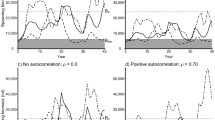Abstract
Conventional surplus production models indicate that destruction of fish populations by overfishing is difficult, if not impossible, but catastrophic declines in abundance of exploited populations are common. Surplus production models also do not predict large continuing fluctuations in yield, but large fluctuations in yield are common. Conventional surplus production models assume that fisheries do not impact the population's capacity to increase, but changes in age structure or a decrease in age-specific fecundity resulting from fishing can decrease the coefficient of increase. A surplus production model is developed in which fishing reduces the capacity of a population to increase; the model is applied to describe the fluctuations observed in yield of lake herring (Coregonus artedii) from the upper Great Lakes. The fisheries of the Great Lakes were decimated by the combined effects of heavy fishing and a changing environment. For some species, yield increased to high levels and then the fisheries collapsed; for other species, yield and effort fluctuated greatly.
Similar content being viewed by others
Literature cited
Abramson, N. J., and P. K. Tomlinson. 1972. An application of yield models to a California ocean shrimp population.Fishery Bulletin 70:1021–1041.
Bails, J. D., and M. H. Patriarche. 1974. Status of selected fish stocks in Michigan's Great Lakes waters and recommendations for commercial harvest. Michigan Department of Natural Resources Tech. Rept. 73-10, 11, 32, and 33. Lansing, MI.
Berst, A. H., and G. R. Spangler. 1973. Lake Huron, the ecology of the fish community and man's effects on it. Great Lakes Fishery Commission Tech. Rept. No. 21, Ann Arbor, MI. 41 pp.
Bertram, P. E., and B. A. Hart. 1979. Longevity and reproductionDaphnia pulex (DeGeer) exposed to cadmium-contaminated food or water.Environ. Pollut. 19:295–305.
Christie, W. J. 1974. Changes in the fish species composition of the Great Lakes.J. Fish. Res. Board Can. 31:827–854.
Graham, M. 1935. Modern theory of exploiting a fishery, and application to North Sea trawling.J. Cons. Int. Explor. Mer. 10:264–274.
Gulland, J. A. 1972. Population dynamics of world fisheries. University of Washington Press, Seattle, WA. 335 pp.
Gulland, J. A. 1977. Fish population dynamics. John Wiley & Sons New York, NY. 372 pp.
Hile, R. 1962. Collection and analysis of commercial fishery statistics in the Great Lakes. Great Lakes Fishery Commission Tech. Rept. No. 5. 31 pp.
Hjort, J., G. John, and P. Ottestad. 1933. The optimum catch.Hvalradets Skr. 7:92–127.
Jensen, A. L. 1976. Assessment of the United States' lake whitefish (Coregonus clupeaformis) fisheries of Lake Superior, Lake Michigan and Lake Huron.J. Fish. Res. Board Can. 33:747–759.
Jensen, A. L. 1978. Assessment of the lake trout fishery in Lake Superior: 1929–1950.Trans. Am. Fish. Soc. 107:543–549.
Jensen, A. L. 1982. Impact of a once through cooling system on the yellow perch stock in the western basin of Lake Erie.Int. J. Ecol. Modelling 1:155–162.
Jensen, A. L., and H. J. Buettner. 1976. Lake trout, whitefish, chubs, and lake herring yield and effort data for State of Michigan waters of the upper Great Lakes: 1929–1973. Michigan Sea Grant Tech. Rep. No. 52. Ann Arbor, MI. 85 pp.
Jensen, A. L., S. A. Spigarelli, and M. M. Thommes. 1982. Use of conventional fishery models to assess entrainment and impingement of three Lake Michigan fish species.Trans. Am. Fish. Soc. 111:21–34.
Jensen, A. L., and J. S. Marshall. 1982. Application of a Surplus production model to assess environmental impacts on exploited populations ofDaphnia pulex in the laboratory.Environ. Pollut. (Series A) 28:273–280.
Jensen, A. L. 1983. Toxicant-induced fecundity compensation: a model of population responses.Environmental Management 7:171–175.
Lawrie, A. H., and J. F. Rahrer. 1973. Lake Superior, a case history of the lake and its fisheries. Great Lakes Fishery Commission Tech. Rept. No. 19. 69 pp.
MacCall, A. D., G. D. Stauffer, and J. Troadec. 1976. Southern California recreational and commercial marine fisheries.Marine Fisheries Review 38:1–32.
Pella, J. J., and P. K. Tomlinson. 1969. A generalized stock production model.Inter. Amer. Trop. Tuna Comm. Bull. 13:419–496.
Ricker, W. E. 1975. Computation and interpretation of biological statistics of fish populations. Fish. Res. Board Can. Bull. No. 191. Ottawa. 382 pp.
Schaefer, M. B. 1954. Some aspects of the dynamics of populations important to the management of the commercial marine fisheries.Inter. Amer. Trop. Tuna Comm. Bull. 1:27–56.
Selgeby, J. H. 1982. Decline of lake herring (Coregonus artedii) in Lake Superior: an analysis of the Wisconsin herring fishery, 1936–1978.Can. J. Fish. Aquat. Sci. 39:554–563.
Slobodkin, L. B. 1962. Growth and regulation of animal populations. Holt, Rinehart and Winston, New York, NY. 184 pp.
Smith, S. H. 1968. Species succession and fishery exploitation in the Great Lakes.J.Fish. Res. Board Can. 25:667–693.
Volterra, V. 1928. Variations and fluctuations of the number of individuals in animal species living together.J. Cons. Expl. Mer. 3:1–51.
Wells, L., and A. L. McLain. 1973. Lake Michigan, man's effects on the native fish stocks and other biota. Great Lakes Fishery Commission Tech. Rep. No. 20. 55 pp.
Author information
Authors and Affiliations
Rights and permissions
About this article
Cite this article
Jensen, A.L. Dynamics of fisheries that affect the population growth rate coefficient. Environmental Management 8, 135–140 (1984). https://doi.org/10.1007/BF01866934
Issue Date:
DOI: https://doi.org/10.1007/BF01866934




